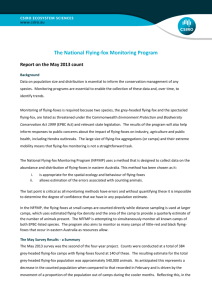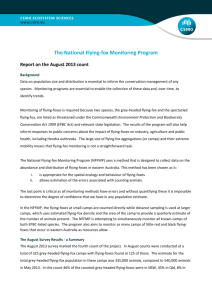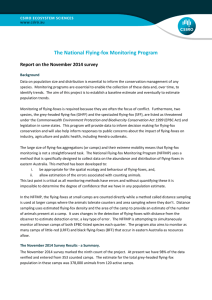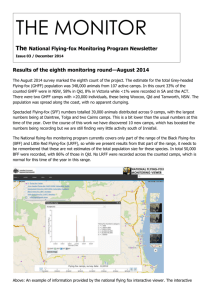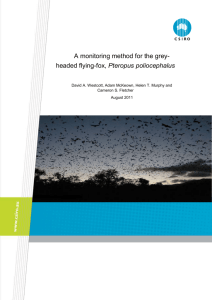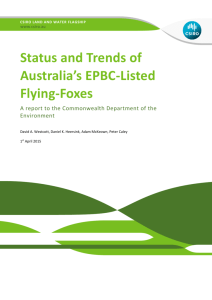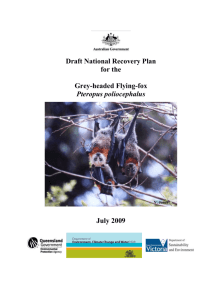The National Flying-fox Monitoring Program Report on the August
advertisement
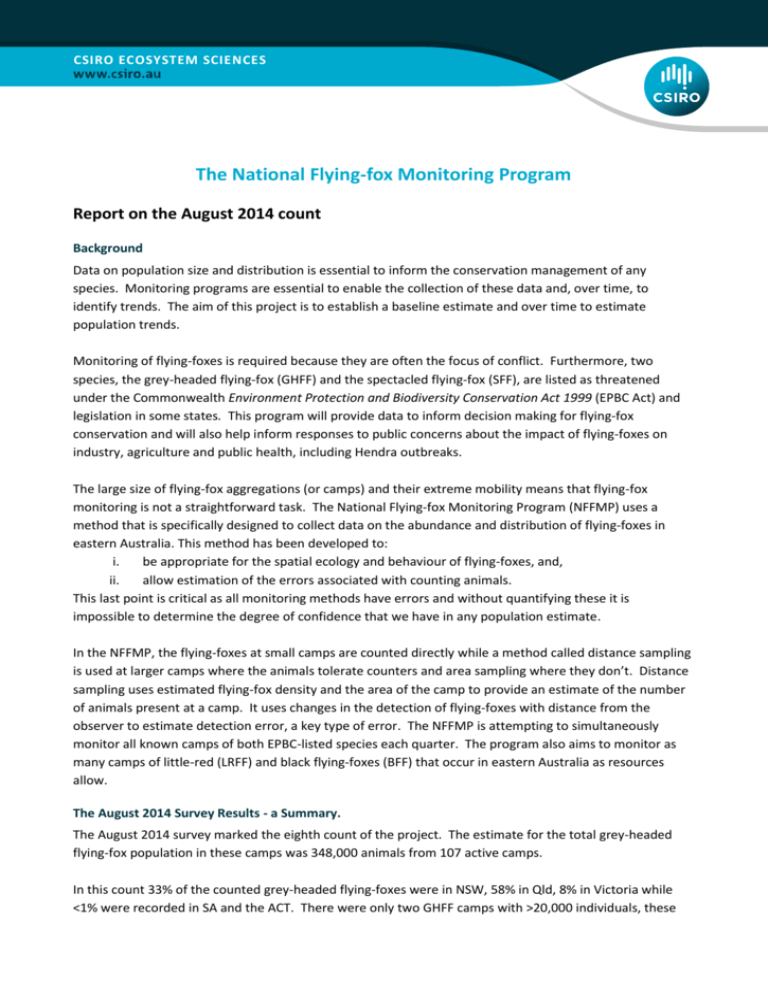
CSIRO ECOSYSTEM SCIENCES The National Flying-fox Monitoring Program Report on the August 2014 count Background Data on population size and distribution is essential to inform the conservation management of any species. Monitoring programs are essential to enable the collection of these data and, over time, to identify trends. The aim of this project is to establish a baseline estimate and over time to estimate population trends. Monitoring of flying-foxes is required because they are often the focus of conflict. Furthermore, two species, the grey-headed flying-fox (GHFF) and the spectacled flying-fox (SFF), are listed as threatened under the Commonwealth Environment Protection and Biodiversity Conservation Act 1999 (EPBC Act) and legislation in some states. This program will provide data to inform decision making for flying-fox conservation and will also help inform responses to public concerns about the impact of flying-foxes on industry, agriculture and public health, including Hendra outbreaks. The large size of flying-fox aggregations (or camps) and their extreme mobility means that flying-fox monitoring is not a straightforward task. The National Flying-fox Monitoring Program (NFFMP) uses a method that is specifically designed to collect data on the abundance and distribution of flying-foxes in eastern Australia. This method has been developed to: i. be appropriate for the spatial ecology and behaviour of flying-foxes, and, ii. allow estimation of the errors associated with counting animals. This last point is critical as all monitoring methods have errors and without quantifying these it is impossible to determine the degree of confidence that we have in any population estimate. In the NFFMP, the flying-foxes at small camps are counted directly while a method called distance sampling is used at larger camps where the animals tolerate counters and area sampling where they don’t. Distance sampling uses estimated flying-fox density and the area of the camp to provide an estimate of the number of animals present at a camp. It uses changes in the detection of flying-foxes with distance from the observer to estimate detection error, a key type of error. The NFFMP is attempting to simultaneously monitor all known camps of both EPBC-listed species each quarter. The program also aims to monitor as many camps of little-red (LRFF) and black flying-foxes (BFF) that occur in eastern Australia as resources allow. The August 2014 Survey Results - a Summary. The August 2014 survey marked the eighth count of the project. The estimate for the total grey-headed flying-fox population in these camps was 348,000 animals from 107 active camps. In this count 33% of the counted grey-headed flying-foxes were in NSW, 58% in Qld, 8% in Victoria while <1% were recorded in SA and the ACT. There were only two GHFF camps with >20,000 individuals, these being Woocoo, Qld and Tamworth, NSW. The population was spread along the coast, with no apparent clumping. SFF numbers totalled 39,000 animals distributed across 9 camps, with the largest numbers being at Daintree, Tolga and two Cairns camps. This is a bit lower than the usual numbers at this time of the year. Over the course of this work we have discovered 10 new camps, which has boosted the numbers we are recording but we are still finding very little activity south of Innisfail. The NFFMP currently covers only part of the range of the BFF and LRFF, so while we present results from that part of the range, it needs to be remembered that these are not estimates of the total population size for these species. In total 50,000 BFF were recorded, with 86% of those in Qld. No LRFF were recorded across the counted camps, which is normal for this time of the year in this range. LRFF numbers in survey area 2,000,000 # SFF 1,500,000 1,000,000 500,000 0 Nov 12 Feb 13 May 13 Aug 13 Nov 13 Feb 14 May 14 Aug 14 A map of the camps covered in the NFFMP surveys can now be viewed at http://www.environment.gov.au/node/16393. Clicking on a camp icon will show a plot of species composition and numbers recorded at that camp during NFFMP surveys. Where were the flying-foxes in August? The heat maps below show the distribution of the different flying-fox species across the region of the NFFMP. The darker the colour the greater the abundance of flying-foxes in an area. Red triangles represent visited camps. As usual a reminder, we have provided numbers to give counters a feel for the outcome of the count and caution that at this point in time they are indicative only. We are still refining analysis methods and estimating some errors. As a consequence it is not yet possible to say what level of confidence can be assigned to the estimate. Describing the errors is a focus of our ongoing research. The aim of the program is to establish a reliable baseline estimate of the flying fox populations and over time to estimate trends. This will take a number of years since each quarterly count will be subject to various factors which will influence the results, making assessment of population size more difficult. We are currently in the second year of the counts. In order to achieve the best possible estimate it is important that surveys are performed using the methods correctly. We are continuing to conduct training sessions and the CSIRO urges any counters who have any questions or concerns about count methodology to contact Dr David Westcott at david.westcott@csiro.au or Mr Adam McKeown at adam.mckeown@csiro.au. We are continually updating the database and adding new camps as we are made aware of them. If you know of camps that are not being counted please contact us at the CSIRO. Thank you to all the counters who put in the hours to assist the program. Your effort is greatly appreciated. If you would like to participate please contact: New South Wales - Stephen.VanDerMark@environment.nsw.gov.au Queensland — Katrina.Prior@ehp.qld.gov.au If you know of additional camps or have questions about the counts please contact: david.westcott@csiro.au or adam.mckeown@csiro.au Additional information about the program can be found at: www.environment.gov.au/biodiversity/threatened/species/flying-foxes-monitoring-program.html The National Flying-fox Monitoring Program is collaboration between the Australian Government, the South Australian, Victorian, New South Wales, Australian Capital Territory and Queensland governments, CSIRO, local governments and volunteers in New South Wales and Queensland. The CSIRO was contracted by the Rural Industries Research and Development Corporation to undertake this research project. This research was funded by the Commonwealth of Australia, the State of New South Wales, the State of Queensland and the Corporation under the National Hendra Virus Research Program.
